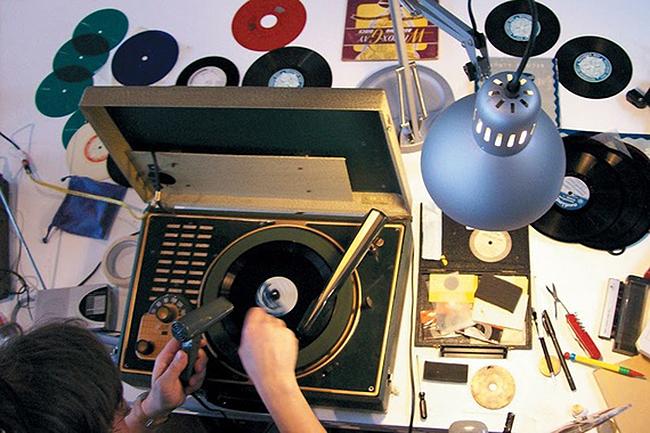
Of course, we’ve heard of people blowing the dust off their LP’s to digitize their old record collections, but this reverse approach spins the idea on its head (oh yes we did).
This process destroys whatever the CD’s original content may have been, but leaves in its wake a series of grooves that can be played back on any turntable.
Wax is bigger than it ever has been for the modern listener – in 2012, vinyl record album sales in the United States jumped 17.7 percent to nearly 4.55 million units. Simultaneously, CD sales continued to decline, dropping 13.5 percent from 2011 to 193.4 million units.
Kolkowski admits that his endeavor isn’t just an artistic or cultural statement. “It’s transforming a disposable media storage device made for cloned copying into a one-of-a-kind cult object,” Kolkowski notes before explaining the ironic other half to his work: “In a way, it’s very tongue in cheek. There’s a lot of fetishism about vinyl, but I see this as quite throw-away, really. I do it for free. People bring a CD and I give them one in return. On a few occasions people have asked me to go into commercial production, but that’s not really my intention.”
The musician has taken his art on a tour of sorts, cutting spontaneous recordings for the various people who show up to witness his unique craft. Some have brought flash drives and requested the transfer of a specific song to one of these repurposed CDs. Kolkowski has even ripped audio from an onlooker’s CD to his own laptop, then carved the content back onto the very same CD, albeit in a much different physical format.

The project is part of a larger body of work devoted to the recycling nature of art. According to The Atlantic’s report, Kolkowski currently has an exhibition —The Exponential Horn: In Search of Perfect Sound — on display at the Science Museum in London. The show’s centerpiece is a “full-size reconstruction of the giant 27-foot-long ‘Denman horn.'” According to the official page for Kolkowski’s show, the original colossal horn (created by old-school engineer and audiophile Roderick Denman) was a popular highlight of the Museum’s daily tours in the 1930s, and the museum refers to the horn clone as “the UK’s largest audio loudspeaker.”


